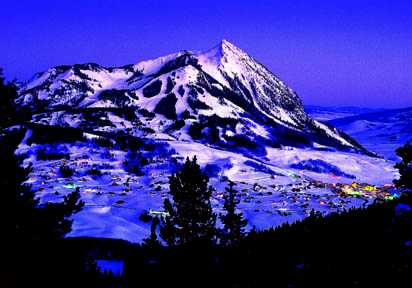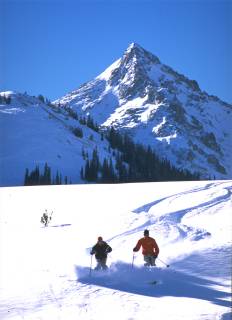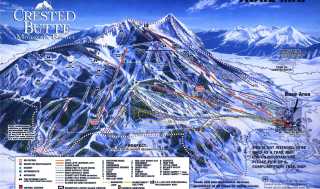Crested Butte, CO – Crested Butte is in many respects the “anti-Colorado resort,” bearing little resemblance to the bustling areas along I-70. Its isolation by road, over four hours from any significant population center, has preserved a small town ambience. The terrain is also like nothing else in the state. Its centerpiece, the North Face, is almost indecipherable by trail map. But most experts will love it for the sense of adventure and exploration that is part of every run there.
 Crested Butte Mountain Resort (photo: Tom Stillo) |
Crested Butte shares the weather profile of many Colorado areas in that light and dry snow accumulates gradually over the season but preserves extremely well due to high altitude and mainly north exposure. But here those factors are taken to an extreme, which expert skiers attracted to the area’s terrain must take into account.
Crested Butte is an isolated peak, almost a sheer cliff on its south side as viewed driving in from Gunnison. West of Crested Butte lies Kebler Pass, home of Irwin Lodge snowcat skiing and one of the snowiest microclimates in Colorado, averaging over 400 inches snow per year. To the north, between Crested Butte and Aspen, is the Gothic area, which averages 340 inches per year. Both of these areas tend to capture much of the moisture from storms before
they reach Crested Butte.
The steep and varied terrain of the North Face requires more coverage than most Colorado ski areas. Considering the terrain and weather, March and early April until closing are the most reliable times for expert skiers to visit Crested Butte. The North Face has been open at New Year’s only once in the past nine years. Some runs usually open by late January, but many not until sometime in February. Crested Butte has hosted the U.S. Freeskiing Championships for 11 years, originally during the mid-February period viewed as peak season by most resorts. After a couple of events with marginal conditions, the competition was moved in 2001 to the first week of April (it will be the last week of March starting 2003) to maximize the odds of adequate coverage.
Since the easier terrain on the front side of the mountain faces west, most beginner and intermediate skiers would prefer February to avoid likely spring conditions later in the season. Most of the expert terrain faces north and retains a winter packed powder surface into April.
Cruising: The Paradise lift services the best cruising terrain. There are some other groomers off the Keystone (flat pitch), Gold
Link (short vertical) and East River (variable conditions) lifts. But the quantity of groomed terrain is small compared to most destination resorts.
Moguls: Twister and International are typical mogul trails.
Moguls on the North Face are nicely spaced due to the lack of defined trails and routes. The hard core should check out the Peel, Banana and Funnel runs, which drop west from the High Lift T-bar for over 2,000 vertical feet. These are severely steep and confined to narrow paths by rocks or trees. This area is rarely covered before February, by which time it is subject to afternoon sun. Don’t go near these runs until they soften up around noon.
Steeps: There are three separate sectors, with the Banana/Funnel area described above being least reliable. Dropping north from the High Lift are Headwall and Big Chute, separated by steep trees. This sector is at over 11,000 feet of elevation with a perfect north exposure that will retain packed powder until the mid-April closing of the ski area.
The majority of Crested Butte’s steeps are accessed by the North Face poma. The North Face is fascinating terrain, the exact opposite of autopilot skiing. It sprawls horizontally for a great distance, with nearly infinite ski lines of around 1,000 vertical feet each. One must always be on the lookout for changes in pitch, bumps, rocks, dropoffs, cliffs, trees of varying spacing, etc. The exposure is generally good, so once the snow gets there it preserves well.
The U.S. Extreme Freeskiing Championships put a premium on snow and terrain reading skills, given the variety of the North Face terrain. It is no coincidence that half of the top 20 finishers in the 2001 event that I witnessed were Crested Butte locals. That March had been warmer and drier than normal at Crested Butte, so the North Face coverage was subpar. Conditions for the extreme comp were described as “bony”, and needless to say the lines chosen by the competitors were much more so than the lines my teenage son Adam and I skied. It was quite interesting to go up and ski the general terrain used in the extreme comp after watching them do it (at higher speed and with a few airs). The somewhat informal atmosphere makes it easy for spectators to mingle with the competitors around the finish area or at après-ski events.
Wide Open Spaces: The specific sector labeled “North Face” on the trail map is Crested Butte’s largest open bowl. It usually has nicely spaced moguls and few obstacles. If the bowl is sufficiently challenging, don’t miss the Easy Out trail that exits skier’s left of the Canaan run under the Paradise lift. Terrain below Easy Out becomes much more technical and confining. The same warning applies to those who traverse skier’s right toward Phoenix-Spellbound before skiing into the fall line. The resort does offer guided tours into the North Face (formerly free, now $20) for those who are not confident to discover its surprises on their own.
Trees: Skier’s left of the North Face becomes gradually more gladed and also meets the Easy Out trail. Below Easy Out and continuing to skier’s right all the way through Staircase are much steeper and tighter gladed routes. Teocalli Bowl and the trees between Headwall and Big Chute are equally steep, but higher on the mountain with wider spacing.
 (photo: Tom Stillo) (photo: Tom Stillo) |
Powder: Huge dumps are rare in Crested Butte’s microclimate, but the limited capacity of the North Face poma and extensive terrain ensures that some powder will last a while. Teocalli Bowl at the top of the High Lift T-bar has the best quality snow as it sheltered and requires a five-minute hike out at the end to return to the rest of the ski area.
Hiking and Backcountry: Out of bounds skiing on the Crested Butte peak itself is prohibited, as most routes would end in sheer cliffs. The previously mentioned Gothic and Kebler Pass areas offer numerous backcountry opportunities in abundant snow.
Crowds: The terrain mix and remote location ensure that Crested Butte will remain an uncrowded and low density area. High speed lifts at Silver Queen and Paradise handle the most popular sectors of the mountain. The North Face poma can run 10-15 minute lines due to its low capacity. This is a necessary evil because the North Face terrain would not handle heavy skier traffic well.
Intermediates: Crested Butte is a limited mountain for intermediates. The quality of intermediate terrain is good, but there isn’t much of it compared to most Colorado resorts. The “surprise around every corner” character of the North Face will be an intimidating factor for skiers who can handle some but not most of its terrain. If in doubt, it’s well worth taking the guided tour.
Novices: The Keystone lift offers 900 vertical feet of ideal novice terrain, a very pleasant environment for learning. Crested Butte does not have the massive acreage of low-end terrain that Summit County has, but it also lacks that region’s thundering hordes of skier traffic.
Children: Crested Butte has a slopeside family-oriented Club Med resort with all-inclusive week-long plans, an ideal setup for an expert skiing couple with young children just starting to learn.
The Town: The historic town of Crested Butte is about three miles down the hill from the ski area. Though small, it’s home to high quality restaurants and shopping, with free shuttle service back to the mountain. Nearly all the lodging is up on the hill, but skiers should examine a local map when booking hotels or condos. Some of the properties are a fair walk from the lifts, especially at 9,100 feet, although shuttle buses are available here as well.
Getting There: For weeklong stays, there are flight connections to Gunnison located about a half an hour to the south. Road warriors need to be prepared for longer drives. Monarch is the closest alternative ski area to Crested Butte at about an hour away. Among larger resorts, Telluride is a three-hour drive, with the Montrose airport in between but closer to Telluride. Allow at least four hours of driving from other Colorado airports or resorts.
Snow Conditions:
Altitude range: 9,100-11,875 feet
Season average snowfall: 240 inches at 10,150 feet
Season standard deviation: 60
High months >=90 in. snowfall: 5%
Low months <=30 in. snowfall: 41%
Average maximum base depth: 67 inches
Direction of exposure: north 60%, east 9%, west 30%, south 1%

